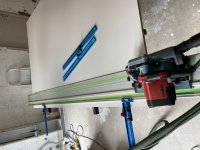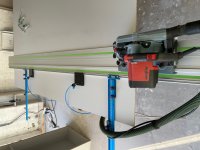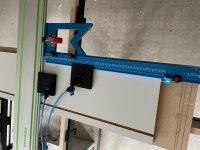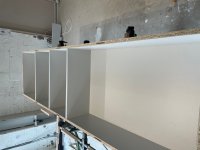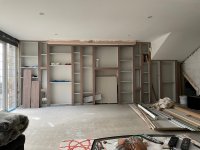I'm faced with indecision on the Festool vs the TSO parallel guides - here is the situation, maybe you can help me steer toward the right direction.
I currently have the Seneca guide set and they're "fine" but I'm interested in upgrading them as I recently bought into the LR32 system and am building more cabinets and seek fine repeatability.
I am drawn to the Festool set after watching Sedge and Brent working them on youtube, the one thing I like the most is that the guiderail can still rest on the material/sheetgood during narrow rips. It looks like calibration is fairly straightforward once you watch the video and get the hang of it, and they appear fairly well balanced if you keep the narrow rip extensions attached at all times.
After reading people ooh and ahh about the TSO set on here in several threads, I started trying to watch some videos to see what the excitement is all about. I see that TSO has tried several times to simplify their offerings in the space and I think after reading and re-reading I mostly understand what I'd need. I already have the GRS-16. What I'm drawn to with the TSO is longer t-tracks and it's hard to ignore the boasting on this forum. The main reason I'm on the fence at this point is that in order to do narrow rips you have to rotate the track 180 degrees and float it off of the material, sending the guides below the track and supporting the track with scraps/offcuts. That seems really clunky to me and since I work off the STM 180 for this type of work it feels like I'd have to start using a sacrificial foam board resting on top of the STM. Also, it's a little unclear what exactly I'd want for a complete set? The TPG-30-50 plus a GRS-16 PE to compliment the GRC-16 I have? And what's this calibration rod memory all about?
I've rambled enough and appreciate your input. Thank you.
I currently have the Seneca guide set and they're "fine" but I'm interested in upgrading them as I recently bought into the LR32 system and am building more cabinets and seek fine repeatability.
I am drawn to the Festool set after watching Sedge and Brent working them on youtube, the one thing I like the most is that the guiderail can still rest on the material/sheetgood during narrow rips. It looks like calibration is fairly straightforward once you watch the video and get the hang of it, and they appear fairly well balanced if you keep the narrow rip extensions attached at all times.
After reading people ooh and ahh about the TSO set on here in several threads, I started trying to watch some videos to see what the excitement is all about. I see that TSO has tried several times to simplify their offerings in the space and I think after reading and re-reading I mostly understand what I'd need. I already have the GRS-16. What I'm drawn to with the TSO is longer t-tracks and it's hard to ignore the boasting on this forum. The main reason I'm on the fence at this point is that in order to do narrow rips you have to rotate the track 180 degrees and float it off of the material, sending the guides below the track and supporting the track with scraps/offcuts. That seems really clunky to me and since I work off the STM 180 for this type of work it feels like I'd have to start using a sacrificial foam board resting on top of the STM. Also, it's a little unclear what exactly I'd want for a complete set? The TPG-30-50 plus a GRS-16 PE to compliment the GRC-16 I have? And what's this calibration rod memory all about?
I've rambled enough and appreciate your input. Thank you.

